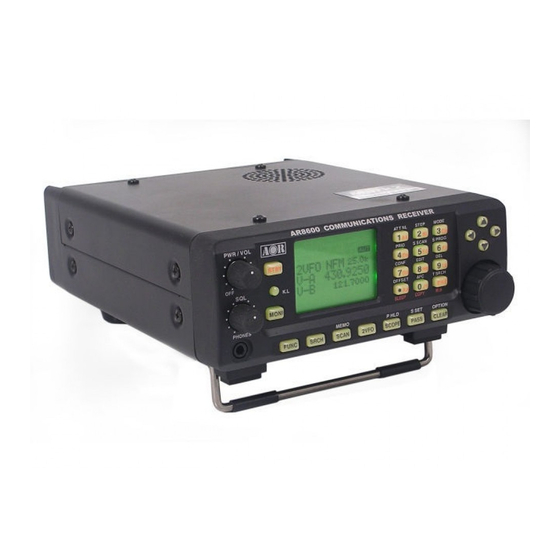Table of Contents
Advertisement
Quick Links
Download this manual
See also:
Operating Manual
Neue Seite 1
AR8600 Bulletin Page
The bulletins contained on this page are not generally intended for self-fit , they generally
represent 'dealer assistance'. Fitting of the optional filters, optional battery and enabling of I.F.
output is intended for action by workshop technicians. No liability is accepted for damage
caused by inexperienced personnel.
Ar8600 Mk1 to MK2
The AR8600 Mark2 has been introduced during June 2002. The main RF PCB is completely
revised, it is not possible to update a Mark1 to a Mark2 by simple component change... the
frequency coverage has also been extended with a revised CPU being employed.
AR8600 I.F. output
The AR8600 is provided with a rear BNC socket which provides 10.7MHz I.F. output. The
bandwidth is about 2MHz and our workshop measurements using WFM mode suggest that a
positive gain exists between aerial input and I.F. output of 35dB to 40dB across the frequency
bands.
Out of the carton box, I.F. output is limited to WFM mode only to minimise the effects of
internal spurii, as the WFM oscillator is used to produce the 10.7MHz I.F. output. If you wish to
obtain I.F. output in ALL MODES, please refer to the associated bulletin (Acrobat PDF file) -
click
here.
While the AR8600 may be used with either the SDU5000 or SDU5500 is passive mode, the
RS232 communication with either spectrum display unit is not supported.
Failure of IC410 - over-voltage (early AR8600 MK1)
We have encountered two AR8600 which have suffered damage due to over-voltage power
being applied to the power socket (20V), one via an unregulated power supply and the other by
vehicle connection. Here in the UK we only supply 12V & 15V 'REGULATED' power
supplies for the AR8600 (UK manufactured)... we cannot comment on power supplies provided
outside of the UK.
In both cases, the voltage regulator on the CPU PCB IC410 (TK11245) had failed, which in
Seite 1
Advertisement
Table of Contents

Summary of Contents for AOR AR8600
- Page 1 I.F. output in ALL MODES, please refer to the associated bulletin (Acrobat PDF file) - click here. While the AR8600 may be used with either the SDU5000 or SDU5500 is passive mode, the RS232 communication with either spectrum display unit is not supported. Failure of IC410 - over-voltage (early AR8600 MK1)
- Page 2 Both components had to be replaced, and it is suggested (by AOR Japan, the equipment manufacturer) that two additional diodes (1N4148 or 1SS1588 or 1SS266) are inserted in series with the un-switched 12V line between connector J403 and the regulator IC410…...
- Page 3 EM8200 external memory slot card with AR8600 Following a report by Bob Farish (direct and via the internet) we investigated a report that memory data was being lost when using the AR8600 with the EM8200 external memory slot card. The problem shows if the single 'memory bank' function is used.
- Page 4 This only happens in the AR8600 (mk1 & 2). It isn't a problem in the AR8200mk3. RU8200 operating manual inconsistencies...
- Page 5 (RECORD ), “ C.REC ” (continuous record) and “ PLAY ” (play). PUSH [ENT] to accept the selection and return to the previous menu or PUSH [CLEAR] to abort. Recording and playback can be carried out while the AR8600 is in VFO, scan or search mode.
- Page 6 Neue Seite 1 18-6-1 Recording While in the record & playback menu select “ REC ” and PUSH [ENT]. The LCD will return to its previous display with the legend “ REC ” in the bottom left corner of the LCD to show that the RU8200 is active.
- Page 7 Lack of SSB reception - resonator replacement We have received two reports of lack of SSB reception with the AR8600 series, either USB or LSB failure. On both occasions, the problem has been traced to failure of the SSB resonator with simple replacement clearing the fault.
- Page 8 All of this is of course far easier if a frequency counter (and signal generator) are available. Re-fitting case parts is the reverse of the above. AR8600 MK1 The procedure is the same as above for the mark 1 sets with the following differences;...

















Need help?
Do you have a question about the AR8600 and is the answer not in the manual?
Questions and answers